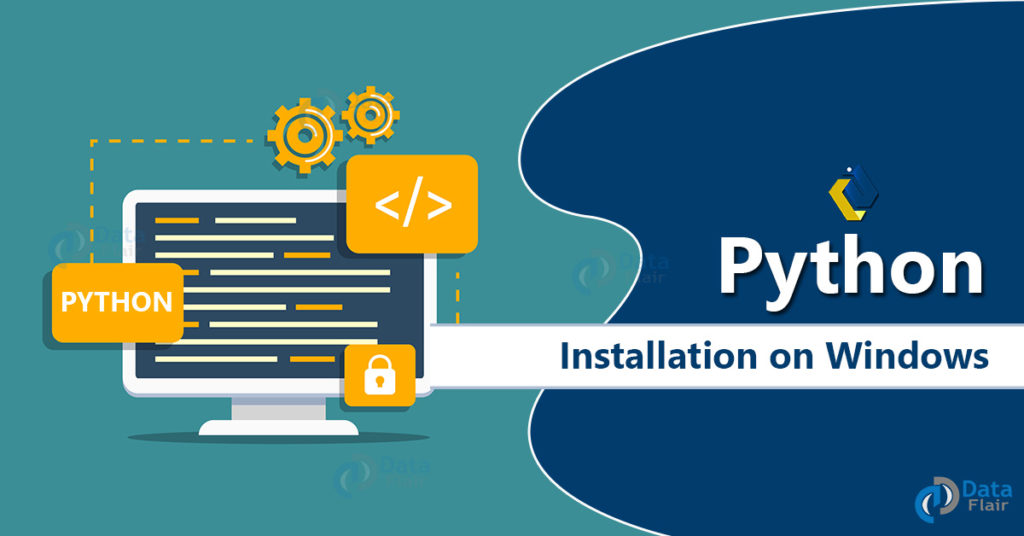Python course with 57 real-time projects - Learn Python
In this Install Python Windows tutorial, we will see how to install python on windows. Along with this, we will discuss possible issues you can face after the installation of Python.
So, let’s start with how to install Python Windows Tutorial.
How to Install Python on Windows?
Installing and running Python on your personal computer is no difficult task. It involves just a few simple steps:
Step 1: Download Python binaries from python.org
Step 2: Install the binaries
Step 3: Add Python to system environment variables
Step 4: Install pip
Step 5: [Optional] Install virtualenv using pip
Python Installation – Video Tutorial
1. Download binaries from python.org
Technology is evolving rapidly!
Stay updated with DataFlair on WhatsApp!!
Install Python 3 on Windows
Firstly, to install Python Windows you need to download the required Python binaries.
We recommend you to download Python latest (Python 3.6.3, currently) installer for Windows.
If you have a different OS, download binaries accordingly. You may choose an x86-64 installer if you have a 64-bit system.
Choose an x86 installer if you have a 32-bit system. But you can also click on the download button in the page header.
2. Install Python binaries
Next, you need to install the binaries you downloaded.
Run the installer. It will show you two options.
Install PIP Windows
This is the default option. It also includes the IDLE (Integrated Development Environment), pip, and the official documentation. It also creates shortcuts.
Customize Python Installation
This option allows you to choose the features that you want.
You will see the following checkboxes:
- Documentation
- pip
- tcl/tk and IDLE- installs tkinter and the IDLE
- Python test suite- This installs the standard library test suite of Python
Advanced Options while Installing Python
- Next, it gives you a set of advanced options:
- Install for all users
- Associate files with Python (requires the py launcher)
- Create shortcuts for installed applications
- Add Python to environment variables
- Precompile standard library
- Download debugging symbols
- Download debug binaries (requires VS 2015 or later)
- You may also specify the location to install the directory at.
Other than these two options, the installer also asks you if you want to add Python to PATH.
We will look at this in step 3. Click ‘Install’ and wait till the progress meter hits the end.
3. Add Python to system environment variables
Locate the Python directory on your computer and append the location to the end of the PATH variable. It may look like this:
C:\Users\lifei\AppData\Local\Programs\Python\Python36-32
An environment variable holds values about the current environment. You need it so you can access Python through the command line.
4. Install pip
If you tick the checkbox for pip in Step 2, pip will install for you.
5. [Optional] Install virtualenv using pip
This step is optional. If you install virtualenv, you can create a virtual Python environment.
Now you don’t need to worry about version conflicts among projects. Use pip to install it:
pip install virtual env
After You Install Python on Windows
You have now installed Python. Now, you can find a list of programs in the Start Menu.
So now, you can reach Python in the following ways:
1. Command Prompt
You can run Python on the command prompt in two ways:
a. The Conventional way
Search for Command Prompt, and type the following:
python
Now, you can use it as an interpreter. As an example, we have calculated 2+3.
b. Using the Start Menu
Open the Start menu. Click on Python 3.6 (32-bit). This will take you to the command prompt for Python. You can now begin coding.
2. The IDLE
You can use the Integrated Development Environment to code in Python.
If you use the Python Shell, you can use it as an interpreter. Otherwise, you can create a new file to write a Python program.
Later, you can save it and click ‘Run’ to run the program.
for a in range(7): print(a)
3. Python 3.6 Manuals (32-bit)
This is the official Python documentation. You can refer to it when you run into an issue with a program.
4. Python 3.6 Module Docs (32-bit)
This takes you to the index of modules available in Python through a localhost.
Possible Issues After Python Installation
- The Python setup may fail if you don’t have Windows Service Pack 1 (SP1) installed on your computer. It is a requirement for installing Python. Download Windows Service Pack 1.
- If it states an unspecified error, try downloading KB2999226. It is an update for Windows 7.
- For other issues, check the log file.
Conclusion
We saw how easy it is to set up an environment for you to install Python on your computer. It does not take more than 5 minutes in the best case. In case if you face any issues, please post in the comments section.
